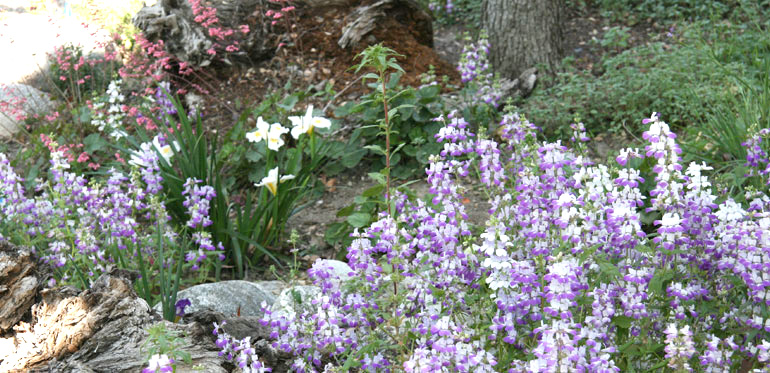
Each year in the GWC Native Garden the first plants to bloom do so around mid-December and early January, initiating a flowering succession that makes a continuous show for seven full months. No month is totally without plants of some attraction or other, though late fall has the least blooming due to prolonged drought of summer. The following schedule names the more prominent plants and the months in which they are usually at their best.
| Month | Prominent Plants |
| January: | manzanitas, currants, and school bells (one of our earliest blooming bulbs) |
| February: | silktassel, barberries, Dutchman’s pipe, fuchsia-flowered gooseberry |
| March: | redbud, pink-flowering currant, California poppy, shooting stars, many native bulbs , trees begin to leaf out and annual wildflowers are blooming including Chinese houses, and California poppies |
| April: | woolly blue curls, summer holly, main ceanothus groups, madrone, douglas irises, pitcher sage, several of the true sages (Salvias) are in bloom now, coast sunflower |
| May: | monkeyflowers, fremontias, carpenteria, tidy tips, bush poppies, California buckeye, brodiaeas, mariposa tulips, cacti, clarkias, mock orange |
| June: | matilija poppy, ocean spray, mariposa lilys, buckwheat, clarkias, columbines, scarlet larkspur |
| July: | red and yellow bush penstemons and other perennial penstemons, scarlet mimulus, island snapdragon |
| August: | wild buckwheats, late penstemons, evening primroses, gum plants, catalina snowflake, berries of coffeeberry |
| September: | California fuchsias, buckwheats, desert willows, beach asters |
| October-November: | fall color of snowberries, berries of the madrone, deciduous oaks, dogwoods, willows, big leaf maple, chaparral currant blooms |
| December: | first manzanita blooms, colorful twigs of deciduous shrubs, and the berries of our toyon are often bright red now |
